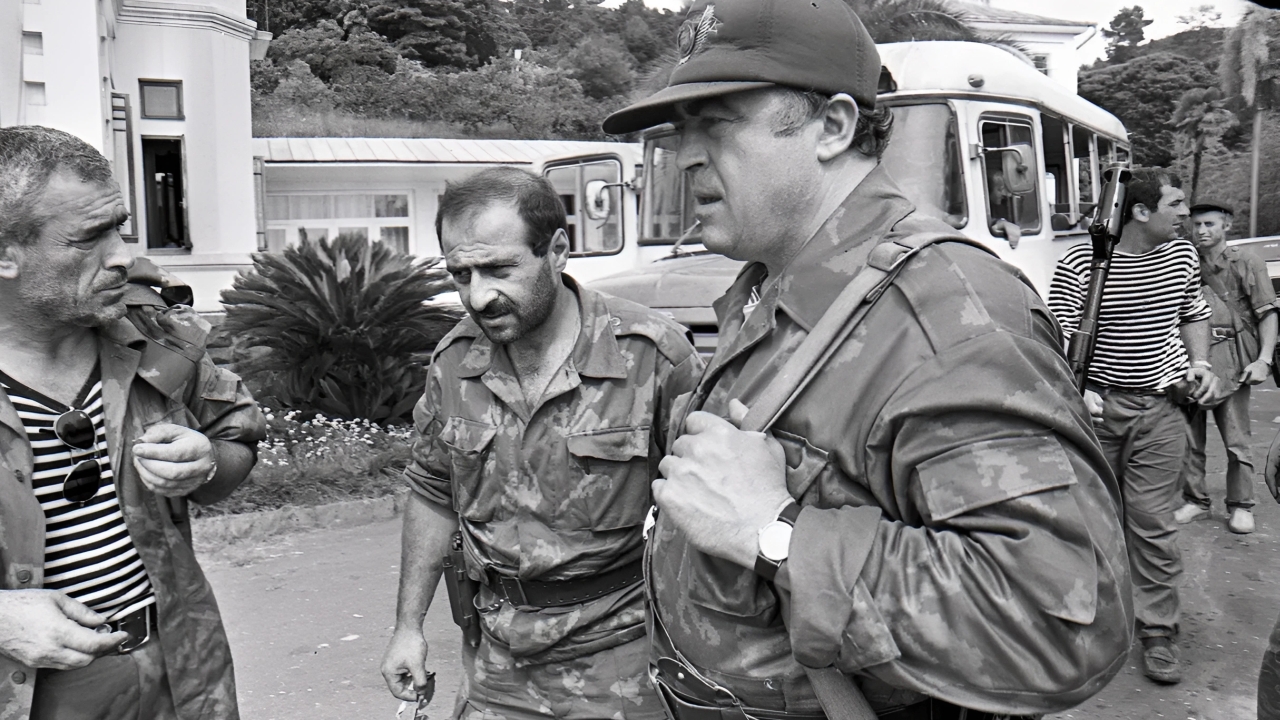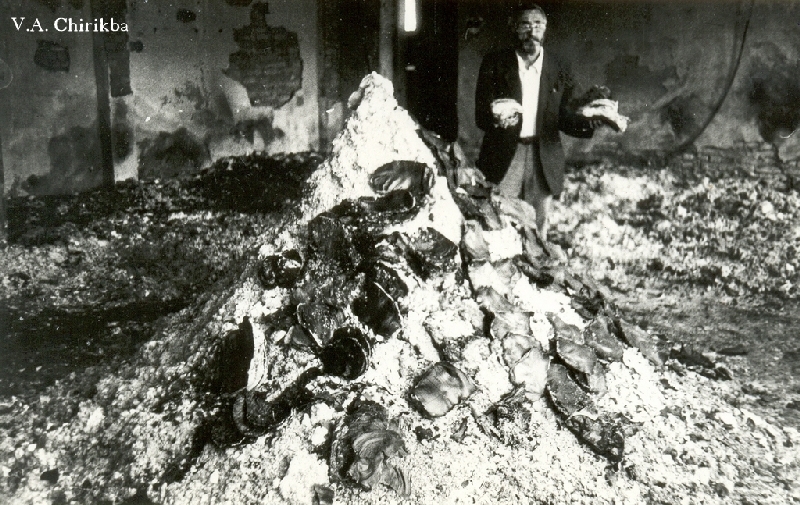14 August 1992
Detachments of the Georgian National Guard entered the territory of Abkhazia. The offensive was supported by air and naval forces and volunteers. According to some sources, Shevardnadze knew about the plan in Moscow, from which Georgia received military equipment (from the warehouses of the Transcaucasian Military District).
15 August, 1992
A Georgian landing-force landed in the village of Tsandrypsh (near Gagra), which in a few days occupied Gagra and took areas to the north-west of it - to the border with Russia. It was not possible in the Georgian units to take control of all the main settlements in the first days of the war. In particular, this was prevented by an explosion under the railway-bridge across the River Ingur, probably committed by Zviadists.
18 August 1992
Georgian troops passed through the Gal, Ochamchira, Gulripsh regions and ended with the establishment of control over Sukhum. Soldiers remove the State flag from atop Government House. In the Ochamchira Region, which is in their hands, partisan-bands actively oppose them.
The Abkhazian government headed by the chairman of the Supreme Council Vladislav Ardzinba moved to Gudauta. Remaining beyond the control of the Georgian forces were the territories from the River Bzyp to the River Gumista (near Sukhum) as well as the city of Tkvarchal, which would be blockaded by Georgian forces from September [sc. to the end of the war].
In the city of Grozny (Chechnya), the Parliament of the Congress of the Mountain Peoples of the Caucasus adopted a resolution to dispatch to Abkhazia groups of volunteer fighters.
+ Georgian-Abkhaz War | FBIS Reports (August-October 1992)
+ North Caucasian Republics Discuss Abkhazia
+ Video | Gia Karkarashvili: We didn’t have a specific goal and we started looting villages
19 August 1992
Georgian troops take control of the city of Gagra.
25 August 1992
The commander of the Georgian army, Gia Karkarashvili, stated on TV that he would sacrifice 100,000 Georgians to kill all 97,000 Abkhazians, if that is what it took to keep Georgia's borders inviolate.
[A similar threat came from the head of Georgia's wartime administration, Giorgi Khaindrava, on the pages of Le Monde Diplomatique in April 1993. Goga (Giorgi) Khaindrava, told the correspondent from Le Monde Diplomatique that "there are only 80,000 Abkhazians, which means that we can easily and completely destroy the genetic stock of their nation by killing 15,000 of their youth. And we are perfectly capable of doing this.'']
3 September 1992
In Moscow, Boris Yeltsin, Eduard Shevardnadze, and Vladislav Ardzinba hold a meeting. They sign a summary document, in which it is agreed that the war shall be halted from 12 o'clock on September 5; that the opposing military forces shall be pulled back everywhere; that Georgian fighters should choose some other place for relocation; and that the legally elected authorities of Abkhazia shall be allowed to resume their work.
5 September 1992
The two sides cease fire and begin mutual reconciliation. Then, at 12.10, Georgian artillery breaks the peace by shelling Abkhazian strongholds in the village of Eshera. At 22.30 Georgian fighters renew the offensive.
9 September 1992
Abkhazians and Georgians negotiating in Sukhum agree to cease fire on the 10th of the month. Georgian fighters disregard this agreement, as well as two subsequent cease-fire agreements on the 15th and 17th of the month.
1-6 October 1992
Georgian troops are expelled from Gagra and its environs. On the 1st of the month at 17.00 hours the Abkhazian fighters attack, taking control of the village of Kolkhida (Psakhara). The Georgian air-force starts to bomb Gagra, resulting in many civilian casualties. At a meeting in Sukhum Eduard Shevardnadze declares: "Gagra always belonged to us and it must continue to belong to us -- we shall soon get it back."
Abkhazian fighters liberate the hamlet of Gechripsh/Gjachrypsh (in Georgian Leselidze) and set up the Abkhazian flag on the Abkhaz-Russian border. Georgian troops cross the Psou and flee headlong to Russian territory. They surrender their weapons to the Russian border-guards.
+ Military Aspects of the War. The Battle for Gagra (The Turning-point), by Dodge Billingsley
+ Changes on the Western Front: how Gagra was liberated
23 October 1992
Georgian special forces in Sukhum burn down the state historical archive of Abkhazia and the archive of the Institute of Abkhazian Language, History and Literature.
+ A history erased - Abkhazia's archive: fire of war, ashes of history
Second Year of the War
15 March 1993
During a counter-attack, Abkhazian fighters crossed the River Gumista and captured strategically important heights near Sukhum. Thus began the operation to liberate Sukhum. However, as on 5 January 1993, the offensive went no further. After bloody battles on 17 and 18 March, the Abkhazian units returned to their original positions. In the March offensive on Sukhum, the Abkhazian army’s losses amounted to 222, and the operation went down in history as an unsuccessful action, but many veterans believe that it was this that became the turning point in the Patriotic War of the people of Abkhazia.
27 July 1993
An agreement to end the war is signed in Sochi.
+ Agreement on a Ceasefire in Abkhazia and Arrangements to Monitor its Observance (Sochi Agreement)
9 August 1993
In a statement sent to Boris Yeltsin and Boutros Ghali, Vladislav Ardzinba draws attention to the contempt with which the Georgian side is treating the Sochi agreement, continuously shelling Abkhazian military divisions and ignoring the timetable for the withdrawal of Georgian military forces from Abkhazia.
16-24 September 1993
The final assault by the Abkhazian fighters. On 16 September they begin attacks on the Eastern front. On 17 September they take control of the River Gumista. On 20th of the month they order the Georgians to lay down their weapons and withdraw, departing via a safe corridor, but the Georgians do not answer. On 21-26th of the month crossfire continues on the main streets of Sukhum. Abkhazian fighters attack successfully in Ochamchira.
27 September 1993
Abkhazian troops reached the centre of Sukhum; by 15:30 the flag of the Republic of Abkhazia fluttered over the building of the Council of Ministers.
30 September 1993
Abkhazia is liberated.
![Abkhazia: [14 August] 1992-2022](/images/banners/logo.png#joomlaImage://local-images/banners/logo.png?width=40&height=33)

